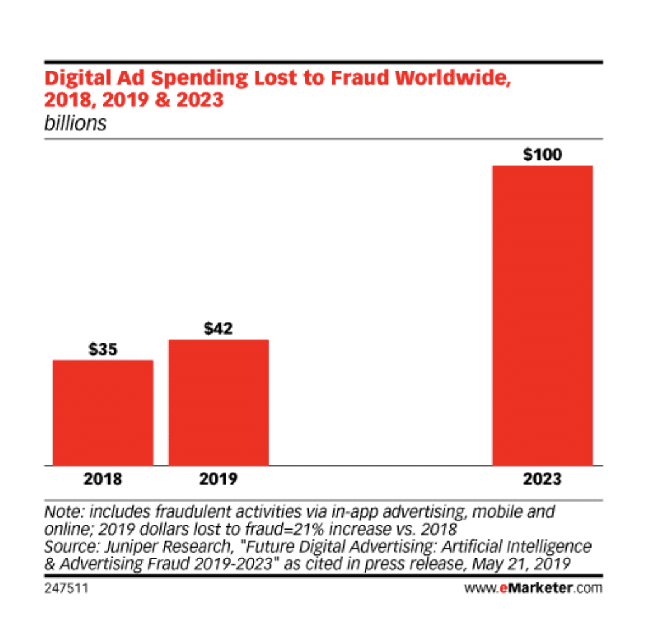Now more than ever, it is critical for marketers to make every impression count by controlling the quality of media they buy or bid on and have transparency into the quality of their media. To ensure that campaigns have the potential to connect with their audiences, advertisers need transparency in the quality of their impressions and they need to pivot towards quality impressions- impressions that are seen by real humans in the right geo and the right environment. Quality impressions remove the negative value of digital and present an opportunity for the advertisers to truly pivot the campaigns to more positive value that really impacts engagement, time-in-view and helps with building performance and brand reputation.
In this article, I’ll be focussing on ad fraud. As advertising budgets keep shifting to digital, fraudsters have found ways to game the system and earn money by serving ads in ways that have no potential to be seen by a real person. Needless to say, this has a negative effect on the entire advertising community. Digital ad fraud is still a major problem for advertisers and their partners throughout the supply chain. Education and awareness have improved, along with detection. Efforts to continue to expose more of the programmatic supply chain are making a difference, but there are still risky pockets of supply and in other emerging mediums like CTV. According to the recent Juniper studies the Ad fraud will be worth 100 billion dollars and if this is really concerning.

IAS reported that in H1 2019, almost 12% of desktop display impressions worldwide were fake, along with a similar share of mobile web display impressions. About 8% of video impressions were fraudulent. Rates of fraud dropped to about 1% or less among impressions that made it past pre-bid verification.
In order to mitigate ad fraud, here are a few suggestions for advertisers to pay attention to:
Trusted- Don’t rely on exclusion lists for ad fraud detection and prevention. We were among the first companies to be awarded the TAG Certified Against Fraud Seal. Our proprietary technology has passed rigorous testing to ensure that you are getting the most accurate and effective results.
Verification- Verification is the foundation to ensure that you are getting the impressions you want, so blocking and measuring ad fraud is a critical component. Whether it’s illegal bot activity or specific page-level fraud, we’re here to protect you. Talk to a trusted verification partner such as IAS today
Optimisation- If you’re buying media, make sure your plan is set up for success by targeting non-fraudulent impressions. If you’re selling media, clean up your inventory with real-time data signals.
In the case of IAS, machine learning and AI powers the critical pieces of our fraud detection technology.
Behavioral and network analysis – We use big data to distinguish real user behavior from bot behavior by looking at anomalies within site visitation patterns. Cohorts of bots tend to visit the same cluster of domains over and over because their behavior is automated. Detecting these patterns can allow us to surface bots based on their behavior. After all, most humans don’t visit the same sites, in the exact same order, multiple times per day. If these cohorts have only visited specific domains that can indicate a pocket of bot activity, we track these patterns and mark this traffic as fraudulent. Of course, machine learning techniques can also identify patterns in traffic that aren’t immediately obvious to human analysts.
IAS observes up to 10 billion impressions per day, the definition of big data. That scale allows us to build machine-learning models that can predict fraud which our peers with more limited scale and singular methodologies cannot. These models allow us to react quickly to new fraud innovations and be more resilient to bots that are trying to thwart our technology. Major consumer brands, like Uber and Amazon, are leveraging big data and machine learning to power major technological innovations, from driverless cars to drone delivery services, and we believe that marketers deserve access to the same predictive technologies to protect their digital investment.
The browser and device analysis – Machine learning allows us to identify invalid traffic sources by matching browser features to the user agent. While this type of determination is often mistakenly labeled deterministic, it would be impossible without employing machine learning methodologies to detect patterns within large data sets. Applied correctly, and powered by sufficient data, this method of detection can help to weed out entire bot networks.
AI-driven automation – Using AI to automate routine processes currently helps us to optimize high-volume, rules-based work. We will continue to expand the use of AI automation in order to enhance scale for our solutions. This technology also helps to integrate cognitive capabilities into business flows in order to better analyze a given situation, learn from it, and reason through it without intervention from a human analyst.
Next-generation machine learning – We are continuing to expand our machine learning capabilities, especially through the adoption of deep learning and reinforcement-learning techniques based on neural networks. These two technologies depend less on existing domain knowledge and ensure optimized results through self-correction of the fraud prevention and detection models.
Ultimately, artificial intelligence will continue to drive change throughout industry and society. For digital advertising, much of that transformation will be powered by AI-driven automation and machine learning that can help us to grapple with the massive data sets produced by large, fully scaled, digital campaigns. IAS is committed to remaining at the forefront of this new technological revolution and making sure that our clients and the industry remain educated about the potential of these technologies to fight fraud and help savvy marketers reclaim lost ad spend.
Laura Quigley is the Managing Director, APAC at Integral Ad Science. Based in Singapore, she builds strong partnerships with clients, agencies, and publishers and helps them solve their pressing business challenges with the use of cutting edge IAS technology solutions. Follow her on LinkedIn.



















